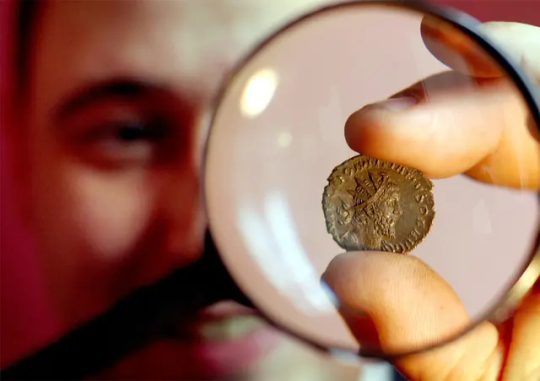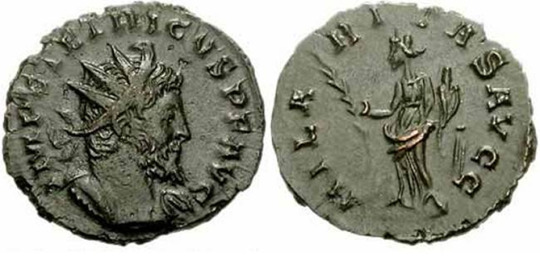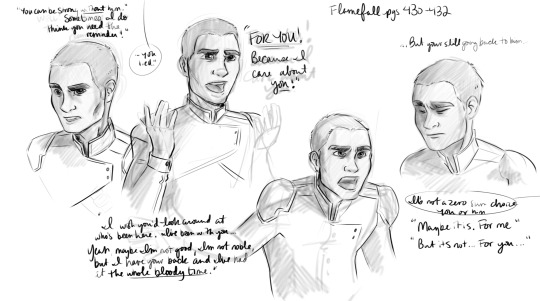#aurelian
Explore tagged Tumblr posts
Text

197 notes
·
View notes
Text



doodled @doctahchang's trek oc hehe :3
#those flakey gold freckles are so galaxy brain i love the colors mwah mwah mwah#My Art#Star Trek: Voyager#Doctahchang#Trill#Baylard#Maliciousalice#Treksona#Sona#Caitian#Aurelian#Kathryn Janeway#Chakotay#Human
54 notes
·
View notes
Text

DogDay as the Roman sun god, Sol Invictus
#drawing#my art#digital art#smiling critters#dogday#ancient rome#roman#roman empire#roman emperor#aurelian#sol invictus
21 notes
·
View notes
Photo

Zenobia's Rebellion in the Historia Augusta
The Historia Augusta (Great History) is a Latin work of the 4th century CE that chronicles the lives of Roman emperors from 117-285 CE. Among the many stories related is the history of Zenobia of Palmyra and her challenge to Roman authority which was crushed by the emperor Aurelian in 273 CE.
Zenobia (b. 240 CE, death date unknown) was the wife of the Syrian governor and founder of the Palmyrene Kingdom, Odaenathus (r. 263-267 CE) who was killed (or intentionally assassinated) on a hunting trip in 267 CE, leaving his young son Vaballathus (b. 259 CE, d. c. 273 CE) as successor. As Vaballathus was too young to reign at the time, Zenobia became regent for their son and expanded the kingdom of Palmyra into an empire.
Her rise to power took place during the chaotic period known as the Crisis of the Third Century (235- 284 CE, also known as the Imperial Crisis) when the central government was weak and various Barracks Emperors succeeded each other rapidly in rule. In this climate, no one noticed - or had the power to deal with - Zenobia's steady expansion of power until Aurelian (r. 270 - 275 CE) came to power and ended her ambitions, drawing the Palmyrene Empire back under the control of Rome. The story of Zenobia's rise and fall is given in a number of ancient works and, among them, is the Historia Augusta.
Historicity of Historia Augusta
While today the Historia Augusta is recognized as largely fictional (some scholars even giving it the label of "historical fiction"), it was considered reliable history in its time and for many centuries afterwards. The famous historian Edward Gibbon (l. 1737-1794 CE) accepted it as an authentic record of the ancient Roman history and relied on it extensively in his six-volume work The History of the Decline and Fall of the Roman Empire which, like the Historia Augusta, is largely viewed as inaccurate in the modern day. Both of these works, however, had significant impact on the audiences who read them or heard them read.
Rather than regard Historia Augusta as largely fictional, it would perhaps be better to consider it in the same light as one would the genre of ancient Mesopotamian naru literature. Naru literature began appearing around the second millennium BCE in Mesopotamia and is characterized by stories featuring a well-known figure from the past (usually a king) as the main character in a quasi-historical tale, which either extolled the king's military prowess, told the tale of his life and reign, or, more often, used the king to exemplify the proper relationship between human beings and the gods. The main character (king) was always an actual historical figure, but the story was either fictional or slanted in a particular way in order to achieve a desired impression.
While the Historia Augusta is not as concerned with the gods as it is with the Roman emperors, the same paradigm applies in that the tales of the Roman rulers are given as "teaching moments" through which one learns what it means to be a good monarch or a poor one, a great man or a failure. The work is certainly biased in its presentation but is understood to have drawn on reliable historical sources for its narratives. The focus of these narratives, however, is always on how effective - or paltry - a given emperor's reign was understood to have been. This model applies not only to the Roman emperors, however, but also to their adversaries and, most notably, to the Queen Zenobia of Palmyra.
Continue reading...
89 notes
·
View notes
Text

My Rough interpretation of the three main dragon breeds from the Aurelian Cycle Trilogy. I might mess with the designs more in sketches later as I reread the series. I feel like I especially struggled to nail down a color I was happy with for the Aurelian in the middle. For a first go at their designs without roughing out thumbnail ideas first I'm pretty happy with them. I gave up a little on coloring towards the end 😅. I need help finding a way to increase my love for the coloring process. I like to sketch and line and then I start to lose interest.
#Fireborne#rosaria munda#dragons#digital fanart#fanart#the aurelian cycle#aurelian#stormscourge#skyfish#furysong#Flamefall
112 notes
·
View notes
Text
This world does not have the magic that we do back home, but there are different types of magic here... I will have to study this so I can bring it back home. Does this magic or, as I heave heard people call it, "elec-tric-ity" come from one of your gods? Or is it a source that you control and share with the world?
19 notes
·
View notes
Text

Aurelian
⋅•✧─────────────☾ ─────────────✧•⋅
Given Name: Aurelian
Weapon: Sword
Element: Cryo
Gender: Male
Constellation: TBA
Region: Fontaine
Affiliations: Opera Epiclese
Special Dish: Extra-Cheesy Garlic Bread (Garlic Baguette)
⋅•✧─────────────☾ ─────────────✧•⋅
A stage performer who excels in the varied tales of Commedia del Arte. Comedy, tragedy, romance, Aurelian has done it all! He stands as a lone Pierrot amongst the thrillseeking shows of Fontaines performance scene, doing his best to keep the original spirit of his beloved stock characters alive despite the declining popularity of classic theater.
⋅•✧─────────────☾ ─────────────✧•⋅
My partners OC and my OCs partner, Aurelian belongs to the lovely @meshiitsukaii. Hi honey!
#amygdala art#oc tag#other peoples ocs#aurelian#genshin impact#genshin oc#oc reference#digital art#digital artist#the boy ever <3
6 notes
·
View notes
Text

some boyager scribblies
#My Art#Star Trek: Voyager#Threshold#AU#Kathryn Janeway#Thomas Paris#Edward Janeway#Coda#Maliciousalice#Sona#Treksona#Baylard#Caitian#Aurelian#Chakotay#Human#JJ Carey
46 notes
·
View notes
Text

Queen Zenobia before Emperor Aurelian by Giovanni Battista Tiepolo
#aurelian#emperor#zenobia#queen#art#giovanni battista tiepolo#ancient rome#roman empire#roman emperor#history#antiquity#rome#roman#emperor aurelian#queen zenobia#syria#syrian#palmyra#spqr#europe#european#asia#empire#triumph#lucius domitius aurelianus#palmyrene#dominus et deus#restitutor orbis#aurelianus#romans
71 notes
·
View notes
Text






oc playlist covers i have been working on forever :3c ✨
#sol meowz#this has been. incredible practice. for faces#truly#also doing new shading + rendering stuff#art#pile of rocks#argent was the hardest because of the stupid fuckass flowers i had to draw on his shirt im blowing him up.#i want to do more of these for. All of my ocs. we'll see#anyways#aurelian#argent#mirai#loki#elliot#mortem
4 notes
·
View notes
Text
I have a bunch of favorite Roman/Byzantine couples, ranging from Factual to Probable to Crackship. Which do you like best? (There’s no other option. You Must Choose)
#my polls#tumblr polls#polls#cicero#clodia pulchra#clodia metelli#nero caesar#nero#gaius petronius#Petronius arbiter#poppaea#poppaea Sabina#Aurelian#queen zenobia#justinian#empress theodora#theodora#belisarius#antonina#ancient rome#byzantium
37 notes
·
View notes
Text

Coin reveals little-known Roman ruler
Treasure hunters have unearthed a coin bearing the head of a virtually unknown Roman ruler who briefly held power in Gaul around A.D. 270 as the empire teetered.
It is only the second coin ever found showing the head of Domitianus, who seized power — and the mint — in the breakaway Gallic Empire, which included modern England, France and parts of Germany and lasted for 15 turbulent years.
“We know next to nothing about Domitianus, except that he was ‘punished’ by the Roman Emperor Aurelian for treason,” Richard Abdy, curator of Roman coins at the British Museum, told Reuters. “But at least now we know what he looked like.”
Studied by coin experts
The first coin bearing Domitianus’ head was found in the Loire area of France in 1900, dismissed as a fake because his name was unknown and then lost from sight in a small museum in Nantes until very recently.
“It is now being studied by numismatists. When I showed our coin to the woman who has been working on it she jumped for joy because it bore out everything she had said about hers,” Abdy said, noting the French coin had been dated to A.D. 271.
The Gallic Empire was established in 260, when rule from Rome was weakening, by Postumus. He was succeeded nine years later by Marius, who held the throne for a matter of weeks before being strangled and in turn replaced by Victorinus, who ruled until 271 when he too was murdered.
Domitianus is believed to have murdered Victorinus, who had a habit of raping the wives of his subordinates, before himself being ousted by Tetricus. Tetricus ruled from 271 to 274, when he was defeated by Aurelian and the empire was restored.

Found on farmland
The British coin, which goes on show at the British Museum starting Wednesday, was found on farmland near Oxford just under a year ago as part of a hoard of 5,000 Roman coins fused together in an earthenware pot.
“It is a type of coin we know as a ‘radiant’ because there are rays radiating from his head. It is a two-denarii piece, which at that time, when they were coining money as fast as they could, would have been worth a couple of hours’ work,” Abdy said.
The base metal coin, which originally had a surface coating of silver, is now conservatively estimated to be worth a five-figure sum, Abdy said.
At the time it was minted, the once-mighty Roman Empire was undergoing a period of intense flux.
The years between 270 and 285 were marked by chaos in the empire, with more than 20 different emperors and 30 different pretenders fighting for power. Only one of these leaders died a natural death.
By Jeremy Lovell.
Original posted Feb. 24, 2004.




The Coin Hoard
Until this discovery was made some scholars doubted the historical significance of Domitianus who is named just twice in the historical sources. The Oxfordshire coin provides archaeological evidence suggesting that he successfully proclaimed himself emperor of a breakaway part of the Roman Empire during the reign of Aurelian (AD 270-5).
Richard Abdy (Curator of Roman coins at the British Museum) said that ‘during the 270s AD the fabric of the Roman Empire had become strained. Breakaway empires, like the so-called ‘Gallic Empire’ that included Britain, were established and ruled by a succession of rebel emperors. Finding a coin produced in the name of Domitianus means that he should now be recognised as one such rebel emperor.’
The failure of Roman writers to identify him as a rebel emperor even led the only other coin of Domitianus – found in France in 1900 – to be dismissed as a modern fake. The new discovery was struck from the same dies that were used to produce this earlier find and has therefore put its authenticity beyond any doubt.
Ian Leins (Finds Adviser, Iron Age and Roman coins, Portable Antiquities Scheme) said ‘the portrait on the new coin very closely resembles that of the rebel emperors Victorinus and Tetricus. It is highly possible that other coins of Domitianus exist in the collections of museums and individuals but have escaped detection. It is important that people start to pay more attention to these often neglected finds and record them with their local Finds Liaison Officer.’
#Coin reveals little-known Roman ruler#coins#collectable coins#roman coins#rebel emperor#Domitianus#Gaul#Gallic Empire#Aurelian#ancient artifacts#archeology#archeolgst#history#history news#ancient history#ancient culture#ancient civilizations#roman history#roman empire#roman emperor
62 notes
·
View notes
Text

The Aurelian Cycle, Flamefall, pages 430-432
Power's Character arch is my favorite in this series. And this is one (of many) of my favorite power moments.
This is also good practice for me because I hate drawing people 🙃 so trying to draw the same person over and over was interesting.
#the aurelian cycle#fanart#dragons#fan art#aurelian#fireborne#digital fanart#flamefall#my art#power sur eater#antigone sur aela#dragon riders
42 notes
·
View notes
Text
There are some fascinating foods here, definitely a unique palette in this realm. Maybe I should learn how to cook some of it to bring it home.
14 notes
·
View notes
Text
Dragon Age Fics



Of Crows and Bastards - Antivan Crow Rook [AO3]
Words: 2,244 - COMPLETE



By Firelight and Folly - Solas x Female Lavellan [AO3]
Words: 2,213 - COMPLETE

8 notes
·
View notes
Note
I know you said before our dear pa and ma don't wear a crown but can mc bring the trend back? Also if you got a Pinterest 👀? Possibly?
I dont have a pinterest, and sure, maybe Aure will piggy back and combine it with the cape to be all drippy haha
Whenever Aure is dripped out, just play this song as his background lmaoooo
youtube

20 notes
·
View notes